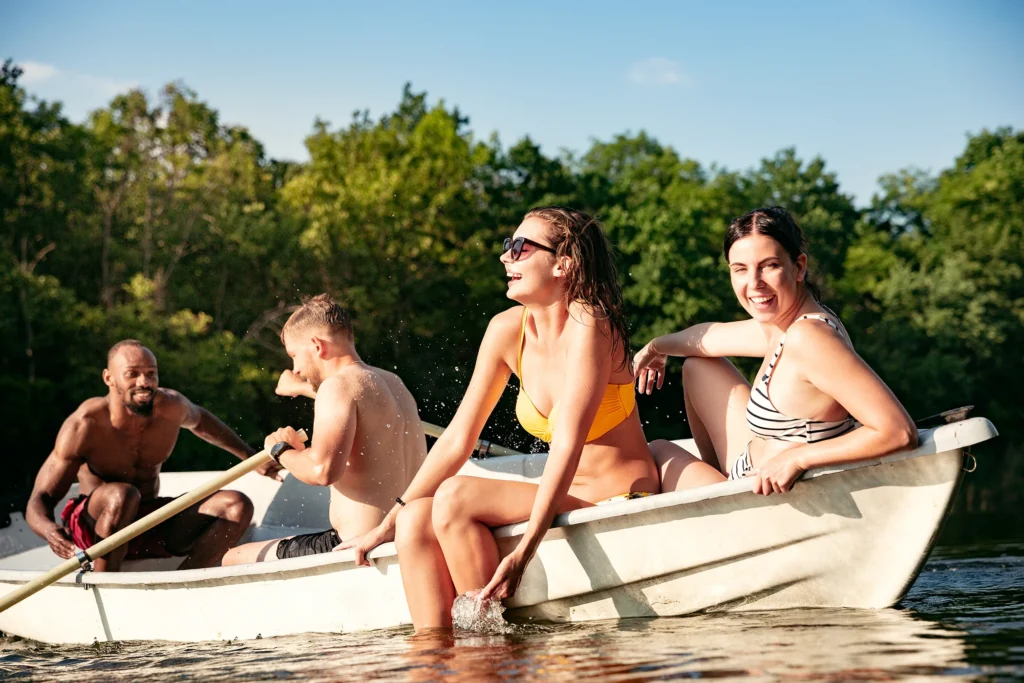Brilliant sunshine reflects off crystal-clear waters. Hours pass unnoticed during engaging outdoor activities. Before you realize it, painful sunburn has already begun forming on exposed skin.
Lake La Croix’s water surface acts like a giant mirror, doubling UV exposure from above and below. This unique challenge requires more than casual sun protection strategies. Thoughtful planning and proper equipment prevent vacation-ruining burns, allowing for the full enjoyment of outdoor adventures.
Understanding Lake La Croix’s Sun Exposure Risks
Water reflection increases UV radiation exposure by up to 15%. Sand and concrete surfaces around the lake add another 10-15% reflection. Combined with direct overhead sun, total exposure can reach dangerous levels within 30 minutes.
Altitude effects remain minimal at Lake La Croix’s elevation. However, clear skies and minimal air pollution create excellent conditions for UV penetration. Cloud cover provides false security; up to 80% of UV rays penetrate light clouds.
Time of day dramatically affects exposure intensity. Peak UV hours occur between 10 AM and 4 PM. During summer months, dangerous exposure levels persist from early morning until evening. Even cloudy days require protection due to scattered UV radiation.
Sunscreen: Your First Line of Defense
Broad-spectrum sunscreen protects against both UVA and UVB radiation. UVA rays penetrate deeper into the skin, causing premature aging and cancer risk. UVB rays create surface burns and immediate damage. Both types require blocking for complete protection.
SPF 30 provides adequate protection for most outdoor activities. Higher SPF numbers offer marginal improvement but create false confidence. SPF 50 blocks 98% of rays compared to 97% for SPF 30. Proper application matters more than SPF numbers.
Water-resistant formulas maintain effectiveness during swimming and sweating. These products resist removal for 40-80 minutes, depending on formulation. However, reapplication remains necessary after toweling off or extended water activities.
Chemical sunscreens absorb UV radiation before it reaches the skin. These products feel lighter and spread more easily. Physical sunscreens containing zinc oxide or titanium dioxide create barriers that reflect radiation away from skin.
Application Techniques for Maximum Protection
Apply sunscreen 15-30 minutes before sun exposure. This timing allows chemical sunscreens to activate and physical formulas to settle properly. Rushed application immediately before going outside reduces effectiveness significantly.
Use approximately one ounce of sunscreen for average adult body coverage. Most people apply only 25-50% of the recommended amounts. Inadequate coverage creates gaps that allow burning despite sunscreen use.
Don’t forget commonly missed areas: ears, feet, back of neck, and scalp (if hair is thin). Lips require special SPF lip balm protection. Eyelids need gentle formulas designed for sensitive skin areas.
Reapplication every two hours maintains protection levels. Water activities, sweating, and toweling remove sunscreen despite water-resistant claims. Set phone alarms to remind yourself during engaging activities.
Protective Clothing: Wearable Sun Defense
UPF (Ultraviolet Protection Factor) clothing provides reliable sun protection without reapplication needs. UPF 50 fabrics block 98% of UV radiation. Unlike sunscreen, clothing protection doesn’t diminish with time or water exposure.
Tightly woven fabrics offer better protection than loose weaves. Dark colors absorb more UV radiation than light colors. Wet fabrics lose some protective ability as water allows UV penetration.
Long-sleeved shirts and pants provide maximum skin coverage. Lightweight, breathable fabrics prevent overheating while maintaining protection. Many outdoor clothing brands now offer UPF-rated options specifically designed for water activities.
Wide-brimmed hats protect face, neck, and ears from overhead sun. Four-inch brims provide adequate coverage for most face shapes. Baseball caps leave ears and neck exposed to dangerous side-angle radiation.
Shade Strategies for Lake Activities
Natural shade from trees offers excellent protection but varies throughout the day. Early morning and late afternoon shadows provide different coverage than midday shade. Plan activities around available natural protection.
Portable shade structures create protection anywhere around the lake. Pop-up canopies, beach umbrellas, and shade sails provide flexible options. Position shade structures to block sun angles that change throughout the day.
Shade ratings vary significantly between products. Look for fabrics with high UPF ratings rather than basic canvas materials. Quality shade structures block 95-99% of UV radiation when properly positioned.
Water Activity Sun Protection
Swimming presents unique sun protection challenges. Water washes away sunscreen while reflection increases exposure. Apply extra sunscreen before entering water, focusing on shoulders and back.
Paddleboarding and kayaking create extended sun exposure with minimal cooling breeze. Wear long-sleeved UPF shirts and wide-brimmed hats. Consider using UV-protective gloves for hands that grip paddles.
Fishing often involves hours of stationary exposure. Neck gaiters protect areas that hats miss. Lightweight, breathable fishing shirts with built-in UPF provide all-day comfort and protection.
Timing Your Outdoor Activities
Morning hours before 10 AM offer gentler sun exposure. Early fishing trips and sunrise photography sessions minimize UV risks while providing excellent outdoor experiences. Cooler temperatures also improve comfort levels.
Midday activities require maximum protection or should be limited to shaded areas. Peak UV hours between 10 AM and 4 PM demand comprehensive sun protection strategies. Consider indoor breaks during these intense periods.
Evening activities after 4 PM allow extended outdoor time with reduced UV exposure. Sunset photography, evening fishing, and campfires become safer and more comfortable as the sun angles decrease.
Special Considerations for Children
Children’s skin burns more easily than adult skin. Thinner skin and less melanin protection create higher vulnerability. Babies under 6 months should avoid direct sun exposure entirely.
Kid-friendly sunscreen formulations reduce stinging and irritation. Mineral sunscreens containing zinc oxide or titanium dioxide work well for sensitive skin. Stick formulas allow easy application around the eyes and lips.
Protective clothing becomes especially important for children who forget to reapply. UPF swimwear, hats, and cover-ups provide reliable protection during extended play. Bright colors help parents monitor coverage.
Eye Protection Essentials
UV radiation damages eyes just like skin. Prolonged exposure increases cataract and macular degeneration risks. Water reflection intensifies eye exposure from unexpected angles.
Sunglasses should block 100% of UV rays. Wraparound styles provide better coverage than small lenses. Polarized lenses reduce glare from water surfaces, improving visibility and comfort.
Prescription sunglasses offer vision correction with UV protection. Photochromic lenses automatically adjust to light conditions. Consider keeping backup sunglasses in your lake bag.
Recognizing Sun Damage Signs
Redness indicates that sun damage has already occurred. Skin cell damage begins before visible signs appear. Pain, swelling, and blistering represent more severe damage requiring medical attention.
Frequent sun exposure without protection can accelerate the aging process. Wrinkles, age spots, and leathery skin texture develop over time. Prevention works better than treatment for long-term skin health.
Unusual moles or skin changes require evaluation by a dermatologist. Annual skin checks become important for people with extensive sun exposure. Early detection dramatically improves treatment outcomes.
Seasonal Sun Protection Adjustments
The spring sun feels gentle but carries significant UV intensity. Cooler temperatures mask burning potential. Start the season with shorter exposures while building tolerance gradually.
Summer demands maximum protection due to high sun angles and extended daylight hours. Cloud cover provides minimal UV reduction. Maintain vigilant protection throughout peak season.
Fall conditions can deceptive with comfortable temperatures but persistent UV exposure. Autumn sun angles remain dangerous despite cooling air. Continue protection through comfortable fall weather.
Product Recommendations for Lake Life
Waterproof sunscreen sticks work well for active water sports. These products resist removal better than lotions. Easy application allows quick touch-ups without a mess.
Spray sunscreens provide quick coverage for hard-to-reach areas. Apply generously and rub in thoroughly. Avoid inhaling spray products, especially around children.
Sun-protective clothing brands offer specialized gear for lake activities. Look for quick-dry fabrics with UPF ratings. Comfort features like ventilation and stretch improve wearability.
Common Sun Protection Mistakes
On a cloudy day, overconfidence can lead to unexpected burns. Up to 80% of UV rays penetrate cloud cover. Maintain protection routines regardless of sky conditions.
Sunscreen expiration dates matter for effectiveness. Old products lose potency and may irritate skin. Replace sunscreen annually or after prolonged storage in high temperatures.
Thinking based on tans provides adequate protection, but creates false security. Tan skin still burns with sufficient exposure. Tanning represents skin damage, not protection.
Creating Your Sun Protection Plan
Assess your skin type and history of burning. Fair skin requires more aggressive protection than naturally darker skin. Previous burns increase the risk of future skin cancer.
Pack comprehensive sun protection supplies before each lake visit. Include multiple types of sunscreen, protective clothing, and portable shade options. Preparation prevents painful oversights.
Educate family members about sun safety. Children learn best through consistent examples. Make sun protection a regular part of outdoor activities.
Ready for Safe Lake Adventures?
Lake La Croix’s natural beauty deserves to be fully enjoyed without painful consequences. Proper sun protection allows extended outdoor time while maintaining healthy skin. Your adventure begins with smart preparation and consistent protection habits.
Plan your sun-safe lake visit today. Your skin will thank you years from now for the protection you provide today.


